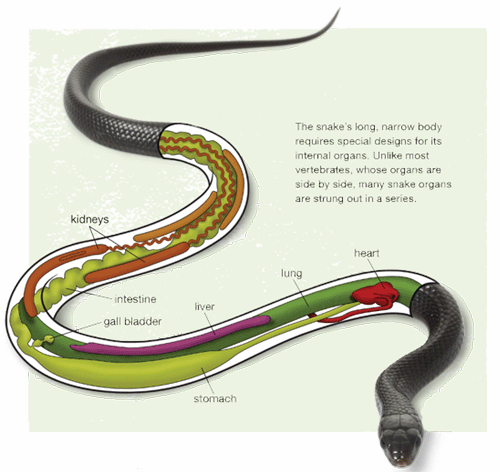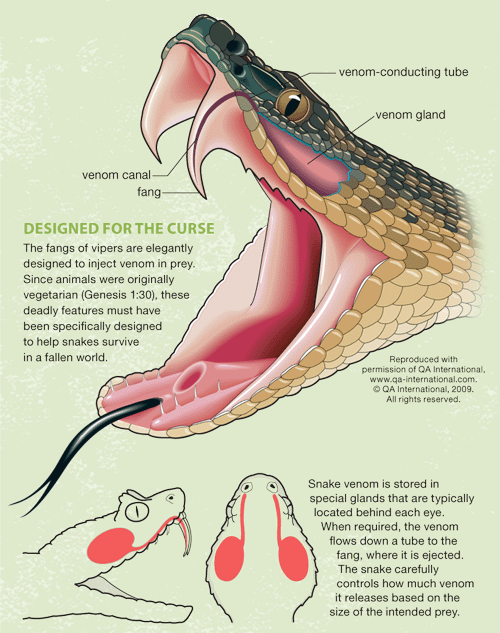
Designed to Kill in a Fallen World
The Incredible Design of Snake Venom
Snakes are killing machines. Nearly every aspect of a snake is clearly designed to hunt and kill. The obvious design demands a designer. It seems that God, who knew what was to come, provided the genetic information necessary so this creature could adapt to a cursed world.
I remember how frustrated I became when, as a young atheist, I examined specimens under the microscope. I would often walk away and try to convince myself that I was not seeing examples of extraordinary design, but merely the product of some random, unexplained mutations.
As I progressed in my education, I came to specialize in herpetology, the study of amphibians and reptiles. I was especially drawn to the designs of the venomous reptiles, and eventually I completed my PhD with a dissertation on rattlesnake venom.
Early in my studies, it became quite evident that the snake’s venom and the venom delivery apparatus were extremely complicated and appeared to have been perfectly designed for their specific purpose. The more I researched, the more obvious it became that every aspect of a snake’s behavior and physique, not just its venom and delivery system, are designed to aid its survival and to sustain its kind on this planet.
As an atheist, I was at a loss for the answers.
Puzzles for Evolution
My research as an evolutionary biologist raised many difficult questions. For example, there are two types of snakes, venomous and non-venomous, and both types appear to be exquisitely designed to kill. Why two? If two species are competing for the same food in the same environment, why hasn’t natural selection eliminated the type that is less suited for survival and procreation?
The questions became more complicated. Venomous snakes produce two very different kinds of venom: neurotoxin (venom that attacks the nervous system) and hemotoxin (venom that attacks the blood or circulatory system). It is hard enough to imagine how snakes could have evolved one group (or class) of complex chemicals, let alone two radically different ones.
For evolutionary biologists, these and many more questions remain unanswered even today, as they attempt to explain the living world in terms of random, beneficial mutations.
A Creationist Perspective
The Bible gave me a whole new perspective on snakes. As a Christian and a creationist, I could now credit the sovereign Creator and Designer, who “made all things for himself . . . even the wicked for the day of evil” (Proverbs 16:4).
The Bible gave me a whole new perspective on snakes.
The fact that snakes are efficient killers no longer bothered me. Based on Genesis 1:30, I knew that they are not what they used to be. God originally made animals to be vegetarian, not killers, but Adam’s Fall changed all that.
Some people have suggested that the snake’s ability to kill arose slowly, as a result of mutations and random changes in behavior after Adam’s sin. While such thinking may help explain some creatures (see the previous article on bacteria), it does not help with snakes.
Modern snakes display a complex, interconnected network of features that appear specifically designed for killing. In fact, all snakes eat the flesh of animals (although a few eat only eggs or insects).
Amazing designs for both a perfect and a cursed world
Some aspects of snake design would work well in the original creation, but they are particularly well suited for a predator in this now-fallen world. For example, the snake has a long, narrow body that allows easier access into holes and burrows to find prey. This unusual shape means that everything inside the body must also be long and narrow. A snake’s stomach is very long, and so are the other organs.
Some snakes, such as the rattlesnake, have only one lung that is almost three-fourths the total body length. Another unique design is that many paired organs, such as the kidneys, are staggered within the body, with one located ahead of the other.
The backbone of a snake is very flexible, allowing for the well-known serpentine movement. With their unique combination of muscles and bone, these versatile predators can move around on the ground and climb or swim without limbs. Some snakes can even flatten their bodies and actually glide through the air from tree to tree.
Bone growth does not stop at maturity, which means that some snakes keep growing throughout their entire lives.
Also, snakes do not have one set of adult teeth that they lose when they are old, as mammals do. Instead, they shed the old teeth and grow new ones. In this current fallen world, this ability is especially critical for venomous snakes, which depend on their fangs to deliver venom to their prey.

Hidden Designs in Snakes
Amazing designs for a cursed world
Other aspects of snake design don’t have any obvious use in the original creation. They seem clearly designed for this cursed world. So we can probably rule out mutations or changes in habitat.
- Did God add these features to snakes at the Curse?
- Did God design the original snakes with these features, knowing that Adam would sin and that snakes would soon need them in a fallen world?
- Did God place these designs in the original snakes’ genes, but they were not expressed until after the Curse as snakes had offspring and spread over the earth (mediated design)?
- Did these designs arise in other ways, which we have not yet considered but are consistent with Scripture? Perhaps we’ll never know.
Consider some of the designs for a fallen world. Snakes have a wonderfully designed sensory system that helps them hunt. In fact, some species of snakes have a particularly sophisticated system that allows them to locate warm-blooded prey in total darkness by sensing their prey’s body heat. With this ability, the snake also determines the approximate weight of its prey so that it can inject the correct amount of venom.
Another unique behavior is seen in vipers. In most cases, they let go of their prey immediately to let the venom do its job. But in the case of birds, the snake continues to hold on until the bird is unable to fly away.
Perhaps the most incredible designs of snakes are the venom and the venom delivery system. Venom in snakes is an adaptation of protein and digestive enzymes, which are made and stored in special glands in the snake’s head.
Snakes use their venom primarily for offensive purposes, to obtain food. Special glands deliver the venom when a snake strikes. Strong muscles around the gland push the venom through a tube and into the hollow fangs, like the hypodermic needle doctors use to give injections.
Most venomous snakes have fangs, although some have special small, grooved teeth that allow the poisonous liquid to flow into the prey when they strike or bite. Several articles could be written to detail all of the diverse designs of fangs, but let’s just consider the viper’s fangs, which are the longest and most elaborate of all venomous snakes. These hollow fangs fold back into the mouth and spring forward during an attack, even rotating independently if needed.

Too Well-Designed to be Accidental
As one examines the snake and weighs all possible evidence, both empirical and circumstantial, the perfection of the design is absolutely overwhelming. Furthermore, both venomous and non-venomous species appear to be specifically equipped to capture and kill prey.
Even as an atheist, I could not get away from the evidence.
The Bible provides a simple solution to the question of design: God made and sustains all things. The concept is simple but incredibly hard for secular-trained scientists to embrace! In most other cases, scientists apply the principle of Occam’s razor, which prefers the simplest idea as the correct one. But when it comes to attributing design to God, we scientists have been trained to complicate the simple. Even in the face of compelling empirical evidence, scoffers continue to reject the simple claims of God’s Word about the Creator and the Curse.
Eventually, by God’s grace, I accepted the simple, yet compelling, truth of the Bible.
Christians know that God made all things, which must include snakes. But how did snakes become predators and some of them venomous if God’s original creation was perfect? These harmful designs must have come into play after the Curse. Consistent with what Scripture reveals, I believe that God, who knew what was to come, designed snakes with the genetic information necessary so they could adapt to a cursed world.
Yet we know that the snake’s present killing designs are temporary. God promises once again to make vipers safe to handle (Isaiah 11:8). What will these snakes (including their teeth) look and act like? It is a matter of speculation, but God’s Word provides the only sure starting point for understanding our world.
Answers Magazine
July – September 2009
How do I deal with cancer? Why did God allow evil in the world? Why do snakes appear designed to kill? God’s curse is a historical reality, and we can see its results in everyday life. Don’t miss this special issue, which will give you the tools to tackle questions about evil and its true origin.
Browse Issue SubscribeRecommended Resources

Answers in Genesis is an apologetics ministry, dedicated to helping Christians defend their faith and proclaim the good news of Jesus Christ.
- Customer Service 800.778.3390
- © 2025 Answers in Genesis





